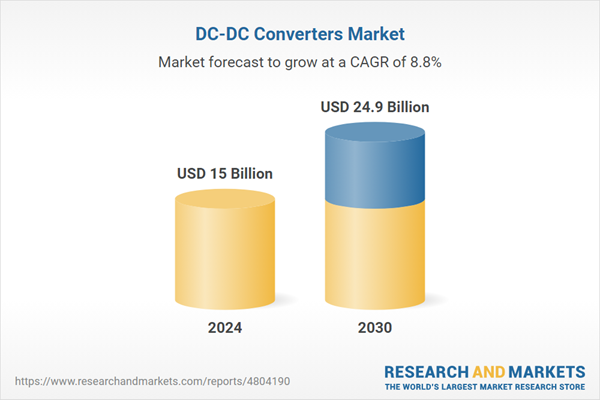The global market for DC-DC Converters was valued at US$15.0 Billion in 2024 and is projected to reach US$24.9 Billion by 2030, growing at a CAGR of 8.8% from 2024 to 2030. This comprehensive report provides an in-depth analysis of market trends, drivers, and forecasts, helping you make informed business decisions. The report includes the most recent global tariff developments and what they mean for your business.
Segments: End-Use (Consumer Electronics, Automotive, Energy & Power, Telecommunications, Aerospace & Defense, Healthcare, Other End-Uses).
Geographic Regions/Countries: World; United States; Canada; Japan; China; Europe (France; Germany; Italy; United Kingdom; Spain; Russia; and Rest of Europe); Asia-Pacific (Australia; India; South Korea; and Rest of Asia-Pacific); Latin America (Argentina; Brazil; Mexico; and Rest of Latin America); Middle East (Iran; Israel; Saudi Arabia; United Arab Emirates; and Rest of Middle East); and Africa.
The analysts continuously track trade developments worldwide, drawing insights from leading global economists and over 200 industry and policy institutions, including think tanks, trade organizations, and national economic advisory bodies. This intelligence is integrated into forecasting models to provide timely, data-driven analysis of emerging risks and opportunities.
Global DC-DC Converters Market - Key Trends and Drivers Summarized
What Are DC-DC Converters and How Do They Function in Electronic Systems?
DC-DC converters are electronic devices that convert a source of direct current (DC) from one voltage level to another. They are essential components in many modern electronic systems, enabling the precise voltage regulation necessary for sensitive electronic devices. These converters play a crucial role in optimizing the efficiency and performance of systems by stabilizing the power supply, regardless of variations in the input voltage or load conditions. This capability is particularly important in portable electronic devices, automotive applications, and telecommunications, where energy efficiency and battery life are paramount. By providing stable voltage outputs, DC-DC converters help extend the operational life and reliability of electronic components.Why Are DC-DC Converters Critical for Advancements in Technology?
DC-DC converters are instrumental in advancing modern technology, particularly in the development and proliferation of portable and compact devices. As electronic devices become smaller, more powerful, and more energy-efficient, the need for effective power management becomes increasingly critical. DC-DC converters allow for more efficient power use, which is essential for maximizing battery life in devices like smartphones, laptops, and medical portable devices. Furthermore, these converters are crucial in renewable energy systems, such as solar power installations and electric vehicles, where they help manage power distribution and conversion from variable renewable sources efficiently and safely.What Challenges Do Manufacturers Face with DC-DC Converters?
While DC-DC converters are beneficial, their design and implementation come with several challenges. One major challenge is the need to balance efficiency with cost, size, and reliability. High-efficiency converters typically require more sophisticated components and circuit designs, which can increase manufacturing costs and complexity. Additionally, as electronic devices continue to shrink in size, the pressure mounts to develop smaller DC-DC converters that fit within these compact architectures without compromising performance. There is also the issue of heat generation; as power densities increase, managing thermal performance becomes more challenging. Manufacturers must innovate continually to improve thermal management techniques without significantly impacting the converter’s size or cost.What Drives the Growth in the DC-DC Converter Market?
The growth in the DC-DC converter market is driven by several factors, starting with the expanding range of applications across various industries. The surge in adoption of electronic devices, particularly portable consumer electronics, has significantly increased the demand for more efficient and compact DC-DC converters. Additionally, the automotive industry's shift towards electric and hybrid vehicles, which require robust power conversion systems, is propelling the market forward. Developments in telecommunications infrastructure and the growing use of IoT devices also contribute to the rising demand for advanced DC-DC converters that offer greater efficiency and miniaturization. Furthermore, advancements in technology that improve converter performance, efficiency, and integration capabilities are enabling new applications in energy systems, driving further market growth. Economic factors, coupled with the demand for sustainable energy solutions, ensure continued investment and innovation in the DC-DC converter market, making it a critical component of modern electronic and power systems.Report Scope
The report analyzes the DC-DC Converters market, presented in terms of units. The analysis covers the key segments and geographic regions outlined below.Segments: End-Use (Consumer Electronics, Automotive, Energy & Power, Telecommunications, Aerospace & Defense, Healthcare, Other End-Uses).
Geographic Regions/Countries: World; United States; Canada; Japan; China; Europe (France; Germany; Italy; United Kingdom; Spain; Russia; and Rest of Europe); Asia-Pacific (Australia; India; South Korea; and Rest of Asia-Pacific); Latin America (Argentina; Brazil; Mexico; and Rest of Latin America); Middle East (Iran; Israel; Saudi Arabia; United Arab Emirates; and Rest of Middle East); and Africa.
Key Insights:
- Market Growth: Understand the significant growth trajectory of the Consumer Electronics End-Use segment, which is expected to reach US$6.7 Billion by 2030 with a CAGR of a 8.5%. The Automotive End-Use segment is also set to grow at 7.0% CAGR over the analysis period.
- Regional Analysis: Gain insights into the U.S. market, valued at $3.9 Billion in 2024, and China, forecasted to grow at an impressive 11.8% CAGR to reach $5.6 Billion by 2030. Discover growth trends in other key regions, including Japan, Canada, Germany, and the Asia-Pacific.
Why You Should Buy This Report:
- Detailed Market Analysis: Access a thorough analysis of the Global DC-DC Converters Market, covering all major geographic regions and market segments.
- Competitive Insights: Get an overview of the competitive landscape, including the market presence of major players across different geographies.
- Future Trends and Drivers: Understand the key trends and drivers shaping the future of the Global DC-DC Converters Market.
- Actionable Insights: Benefit from actionable insights that can help you identify new revenue opportunities and make strategic business decisions.
Key Questions Answered:
- How is the Global DC-DC Converters Market expected to evolve by 2030?
- What are the main drivers and restraints affecting the market?
- Which market segments will grow the most over the forecast period?
- How will market shares for different regions and segments change by 2030?
- Who are the leading players in the market, and what are their prospects?
Report Features:
- Comprehensive Market Data: Independent analysis of annual sales and market forecasts in US$ Million from 2024 to 2030.
- In-Depth Regional Analysis: Detailed insights into key markets, including the U.S., China, Japan, Canada, Europe, Asia-Pacific, Latin America, Middle East, and Africa.
- Company Profiles: Coverage of players such as Artesyn Embedded Technologies, Inc., Bel Fuse, Inc., Cosel Co., Ltd., Crane Aerospace & Electronics, Delta Electronics, Inc. and more.
- Complimentary Updates: Receive free report updates for one year to keep you informed of the latest market developments.
Some of the 46 companies featured in this DC-DC Converters market report include:
- Artesyn Embedded Technologies, Inc.
- Bel Fuse, Inc.
- Cosel Co., Ltd.
- Crane Aerospace & Electronics
- Delta Electronics, Inc.
- Ericsson AB
- FDK Corporation
- General Electric Company
- Murata Manufacturing Co., Ltd.
- Texas Instruments, Inc.
- Traco Electronic AG
- Vicor Corporation
Tariff Impact Analysis: Key Insights for 2025
Global tariff negotiations across 180+ countries are reshaping supply chains, costs, and competitiveness. This report reflects the latest developments as of April 2025 and incorporates forward-looking insights into the market outlook.The analysts continuously track trade developments worldwide, drawing insights from leading global economists and over 200 industry and policy institutions, including think tanks, trade organizations, and national economic advisory bodies. This intelligence is integrated into forecasting models to provide timely, data-driven analysis of emerging risks and opportunities.
What’s Included in This Edition:
- Tariff-adjusted market forecasts by region and segment
- Analysis of cost and supply chain implications by sourcing and trade exposure
- Strategic insights into geographic shifts
Buyers receive a free July 2025 update with:
- Finalized tariff impacts and new trade agreement effects
- Updated projections reflecting global sourcing and cost shifts
- Expanded country-specific coverage across the industry
Table of Contents
I. METHODOLOGYII. EXECUTIVE SUMMARY2. FOCUS ON SELECT PLAYERSIII. MARKET ANALYSISSOUTH KOREAREST OF ASIA-PACIFICARGENTINABRAZILMEXICOREST OF LATIN AMERICAIRANISRAELSAUDI ARABIAUNITED ARAB EMIRATESREST OF MIDDLE EASTIV. COMPETITION
1. MARKET OVERVIEW
3. MARKET TRENDS & DRIVERS
4. GLOBAL MARKET PERSPECTIVE
UNITED STATES
CANADA
JAPAN
CHINA
EUROPE
FRANCE
GERMANY
ITALY
UNITED KINGDOM
SPAIN
RUSSIA
REST OF EUROPE
ASIA-PACIFIC
AUSTRALIA
INDIA
LATIN AMERICA
MIDDLE EAST
AFRICA
Companies Mentioned (Partial List)
A selection of companies mentioned in this report includes, but is not limited to:
- Artesyn Embedded Technologies, Inc.
- Bel Fuse, Inc.
- Cosel Co., Ltd.
- Crane Aerospace & Electronics
- Delta Electronics, Inc.
- Ericsson AB
- FDK Corporation
- General Electric Company
- Murata Manufacturing Co., Ltd.
- Texas Instruments, Inc.
- Traco Electronic AG
- Vicor Corporation
Table Information
| Report Attribute | Details |
|---|---|
| No. of Pages | 223 |
| Published | April 2025 |
| Forecast Period | 2024 - 2030 |
| Estimated Market Value ( USD | $ 15 Billion |
| Forecasted Market Value ( USD | $ 24.9 Billion |
| Compound Annual Growth Rate | 8.8% |
| Regions Covered | Global |









